
|

|

|

|
Kenwood
TS-50 / 50S
Scrolling down for
all information
| DBS
Speech processor for the Kenwood
TS-50 |
(Speech clipping in the TS-50, RSGB's RadCom June
1997)
INTRODUCTION
For DX work a speech pocessor should be an
advantage but the KENWOOD TS-50 does not have one. The simple speech
clipper proposed here does add punch to the signal. It produces more
distortion within the pass band than SSB clipping, but if the microphone
gain is not set to high this is inaudible; it causes no platter.
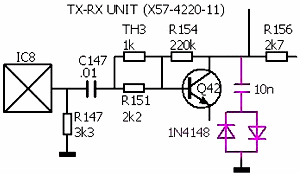
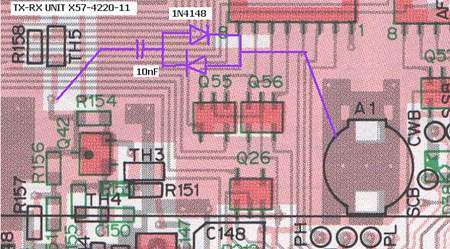
Fig 1
DESCRIPTION
The clipper (Fig 1) consist
of a pair of back-to-back 1N4148 diodes in series with a 10 nF DC-blocking
capacitor. It is connected between the collector of Q42 and earth
(threaded bushing A1) on the TX-RX UNIT (X57-4220-11). Q42 is the 10.695
MHz double-sideband amplifier between the balanced modulator and the 2.4
kHz SSB filter. The latter removes intermodulation products of the
clipping proces outside the normal pass band. This clipper also eliminates
the tendency of the TS-50 to splatter when speaking into the microphone
too loudly.
INSTALLATION
Refer to the manual on page
55.
- Remove the lid.
- Remove the speaker and
its mounting plate.
- Unscrew and carefully
remove the IF filter PCB.
- Locate with figure 1 the
clipper connection points on the main PCB and solder, using the threaded
bushing A1 as the earth point.
- Check the clearance
between the clipper components and the filter PCB.
- Reassemble.
ADJUSTMENT
- In CW mode, send a fast
string of dots into a dummy load through an analogue SWR/power indicator
and note the average meter deflection.
- Swith to menu B nr. 66
"H".
- Switch to SSB and speak
into the microphone in a normal voice.
- Adjust the (yellow) VR7
for an average meter reading just below the one previously noted.
| Kenwood TS-50 programming info, COM
command |
| sNotes on communicating with
the TS50 - it appears to be the standard
Kenwood format that most of their radios
use.
Kenwood TS-50 programming
info:
Full duplex serial, 4800 Baud, 1
start, 8 data, 2 stop bits No parity, TTL
level
Commands consist of a 2-char
command, parameters, and a semicolon
terminator
Error messages: ?; - Syntax error or radio in wrong mode
E; - Communications error
O; - Processing not complete
FA00007000000; Set VFO A to 7 MHz. Freqs are 11 digits, in Hz
FA; Read VFO A
FB00007000000; Set VFO B to 7 MHz. Freqs are 11 digits, in Hz
FB; Read VFO B
FNx; Select VFO A (x=0), VFB B (x=1) or MR (x=2)
ID; Read radio ID - TS-50 is 013
IF; Read info from radio - answer is
IFaaaaaaaaaaa bbbbbc ddefghijkk ;
a: 11 digits of frequnecy. b: RIT offset in Hz - first char is +
or -.
c: 0-rit off, 1-rit on d: memory channel. e: 0-rx, 1-tx f:
mode
g: 0-VFO A, 1-VFO B, 2-MR, h:scan off/on i: split off/on j:
tone off/on
k: ctcss frequency
MDm; Set mode to m
TX; Transmit
RX; Receive
SPa; Split off (a=0) or on (a=1)
mode: 1 - lsb, 2 - usb, 3 - cw, 4 - fm, 5 - am
CTCSS: 38 standard tones numbered 01 (67.0) - 38 (250.3) or 39 (1750
Hz)
| | | | |
| Factory
Adjustments
Hold down NB and MHz keys
+ Power ON.
Turn the Frequency Tuning knob to
change menu number.
A0 Checksum diplay (version of YOUR installed pgm)
A1 RIT center Initial value 80
A2 IF-Shift center Initial value 80
A3 LSB carrier point Initial value 0
A4 USB carrier point Initial value 0
A5 S-meter adjust S1 (not FM) Initial value 2E
A6 S-meter adjust S9 (not FM) Initial value 73
A7 S-meter adjust full (not FM) Initial value C2
A8 S-meter FM start Initial value 91
A9 S-meter FM full scale Initial value CC
AA RF-meter adjust low (10W) Initial value 3C
AB RF-meter adjust middle (50W) Initial value 80
AC RF-meter adjust high (100W) Initial value B1
AD Write to Eprom by pressing UP or DOWN key. | | | | |
| Kenwood TS-50 to Icom and LDG ATU
Interface | |
| TThis article describes the result
of my investigations into connecting automatic
ATUs to the Kenwood TS-50 HF transceiver. I
wanted to use my TS-50 in a mobile environment,
but was irritated by the lack of integration
between it and the Icom AH-2 automatic ATU that
I was also planning to use. All of the mode and
power switching required to get the automatic
ATU to tune seemed to me to be a waste of
effort, and possibly dangerous while driving.
There had to be a better way.
I
started off by looking on the web for
information – but there appeared to be very
little out there. On www.mods.dk, my usual first
port of call for these sorts of things, the
closest I got was a writeup by DF6KR on TS-50 to
AT-50 serial communications – these two boxes
talk using a 4800bps inverted serial
communications scheme. Having found this I
decided that a small microcontroller could
easily emulate the AT-50 and provide control to
a dumber ATU. However, by accident while
collecting further information on the serial
protocol I made a wiring error and an
interesting discovery.
Dumb Mode
It
turns out that the ATU interface on the TS-50
can work in two different modes. As well as the
serial interface scheme there is a second mode.
If you link the TS and TT signals on the ACC
(ATU) connector then the TS-50 detects this at
powerup and goes into this alternative 'dumb'
ATU control mode.
This mode has the following
features:
- The AT TUNE button starts to work.
Pressing the AT TUNE button on the rig will
temporarily select low power, and key the
transmitter in CW mode. Pressing the button
again will cancel this and return the rig to
normal operation. If the tune operation is not
cancelled within 30 seconds the TS50 starts
beeping at you to remind you that the
transmitter is still active. Thus with no
changes other than a loopback wire you can have
a single button to perform the necessary
transmitting for atu
autotuning.
- While the rig is idle the TS
signal sits at 5V. During the AT TUNE operation
it drops to 0V, taking TT with it (as they're
looped). You can detect this state change and
use it to trigger an ATU tune
cycle.
- If during the ATU tune cycle you
break the TS/TT loop for a short period (a few
hundred milliseconds) and allow TT to float high
then the AT tune operation ceases, and TS
returns to 5V. This will allow a simple circuit
to monitor the 'key transmitter' line from the
ATU, and temporarily break the TS/TT loopback
when transmitters keying ceases, to end the
TS-50 transmit cycle.
Note that (at least on my TS-50)
the TS and TT interface signals comprise the
centre column of contacts on the ACC connector.
TS is on the bottom, and TT on the top. On one
of the mods sites I've seen a different set of
pinouts for the ACC connector - this is either
wrong or there's more than one possible wiring
setup out there.
Note also that the TS-50 does its
'dumb mode' detection at power up. It brings TS
high, then pulses it low for about 120ms. Any
'tune detect' circuit should thus make sure that
TS has stayed low for longer than this before
starting the antenna tune cycle.
Interface Circuit
The diagram shows the circuit I
used to make the interface to an Icom AH-2 ATU
work. The TS/TT loopback is provided by (one
quarter of) a 74HC4066 analog switch device.
This device loops back TS to TT whenever the
control input on pin 13 is high, which is most
of the time. Note that the control inputs for
the unused switches on the 74HC4066 (pins 5, 6
and 12) are grounded.
The top half of the 74HC123 dual
monostable is used to deliver a positive pulse
of approximately 500ms duration when a negative
edge is sensed on the TS/TT loop, indicating
that a tune operation has commenced. This pulse
turns on the BC549 transistor, grounding the
TUNE signal and initiating tuning on the ATU.
The bottom half of the 74HC123 is
used to detect a positive edge on the KEY signal
(on the LDG RT-11 ATU this is called 706-OUT,
probably because the Icom interface uses it)
from the ATU, signifying that the ATU has
finished keying the transmitter. Upon sensing
this, it delivers a negative pulse of
approximately 500ms duration to the switch input
of the 74HC4066, breaking the TS/TT loopback for
this period. This tells the rig that tuning is
complete.
Power for the interface is
provided using a 74L05 miniature 5V regulator,
running from the 12V feed from the TS-50 ATU
connector. The resistor and zener on the
regulator input are to provide extra protection
from ignition spikes in a mobile environment -
but may not be so necessary as the TS-50 has an
internal protection diode. Note that I've not
included a fuse on the drawing - the TS50 has an
internal 4A fuse on the ATU interface 12V output
line - but on reflection putting a low current
fuse in the power feed prior to the voltage
regulator is probably a good idea. The circuit
itself should draw no more than a few milliamps.
This circuit could probably be
improved with better understanding of the TS-50.
It's still based on my observation that looping
back TS/TT puts the ATU interface into 'dumb'
mode. My initial attempt at a design took a
logic interface approach to the TS/TT
connection, but I found that in some
circumstances it appeared that TT was also
driving the loop, and so this approach didn't
work. The use of the 74HC4066 is thus a little
bit of laziness - as an analog switch it's the
closest thing to a real loop I could easily
control, and it stops me from having to
understand the full complexities of the
interface. In my original breadboard I used a
normal CMOS 4066 rather than the 74HC flavour.
It worked fine, but Len (a greybeard hardware
engineer friend who kindly reviewed my design)
suggested that the 74HC version has a lower on
resistance and will work better with 5V logic
levels on the switch input.
My
interface works happily with the Icom AH-2 ATU -
I believe the AH-3 and AH-4 also have the same
interface. The LDG Electronics RT-11 has an
effectively identical interface, too. Note that
if the ATU tunes very quickly (< 0.5 second)
at times then you may need to reduce the length
of the TUNE pulse, otherwise it may try to tune
a second time just as the transmitter turns off.
You'd do this by reducing the values of the
resistor and/or the capacitor on pins 14 and 15
of the 74HC123. Pulse duration is about 0.45
times the product of the resistor and capacitor
values.
ACC Connector
You can make an adequate if not
beautiful substitute for a real ACC plug on the
TS-50 from a broken ATX style (modern) PC power
supply. If you don't have one in your junkbox
you may be able to charm one out of your local
PC clone shop - mine didn't even charge me,
which may say something about PC power supply
reliability! The main connector that goes onto
the PC motherboard from these power supplies is
the correct pitch, but has far too many
contacts, some of the wrong shape. With some
judicious scalpel work you can reduce the
connector to six contacts, and then remove all
of the plastic on the three of these that go
into the circular holes, leaving only the pins.
This latter part of the process is easiest done
with the metal pins removed, which you can do
with a fine screwdriver and a bit of fiddling.
Once you've formed the connector
and proved it fits you can then also cut away
sufficient of the locking tab that the connector
will hold in place correctly despite being
offset by half a pin from its correct location.
Of course, if you can find a retailer who'll
sell a small quantity JST brand ELP-06V plugs
and associated pins then you have no need of
this workaround. I've not been so lucky thus
far.
Summary and Disclaimer
With a handful of cheap components
it is possible to connect a TS-50 to several
different automatic ATUs. This exercise solved a
problem for me – I hope it makes life easier for
you too. I’m always interested in feedback on
this design – so feel free to get in touch at
the email address above if you have comments.
Please also understand - this
article is published in good faith, and I’m
using the circuit myself, but in the end the
responsibility for any blown up rigs or ATUs is
yours alone. Take care.
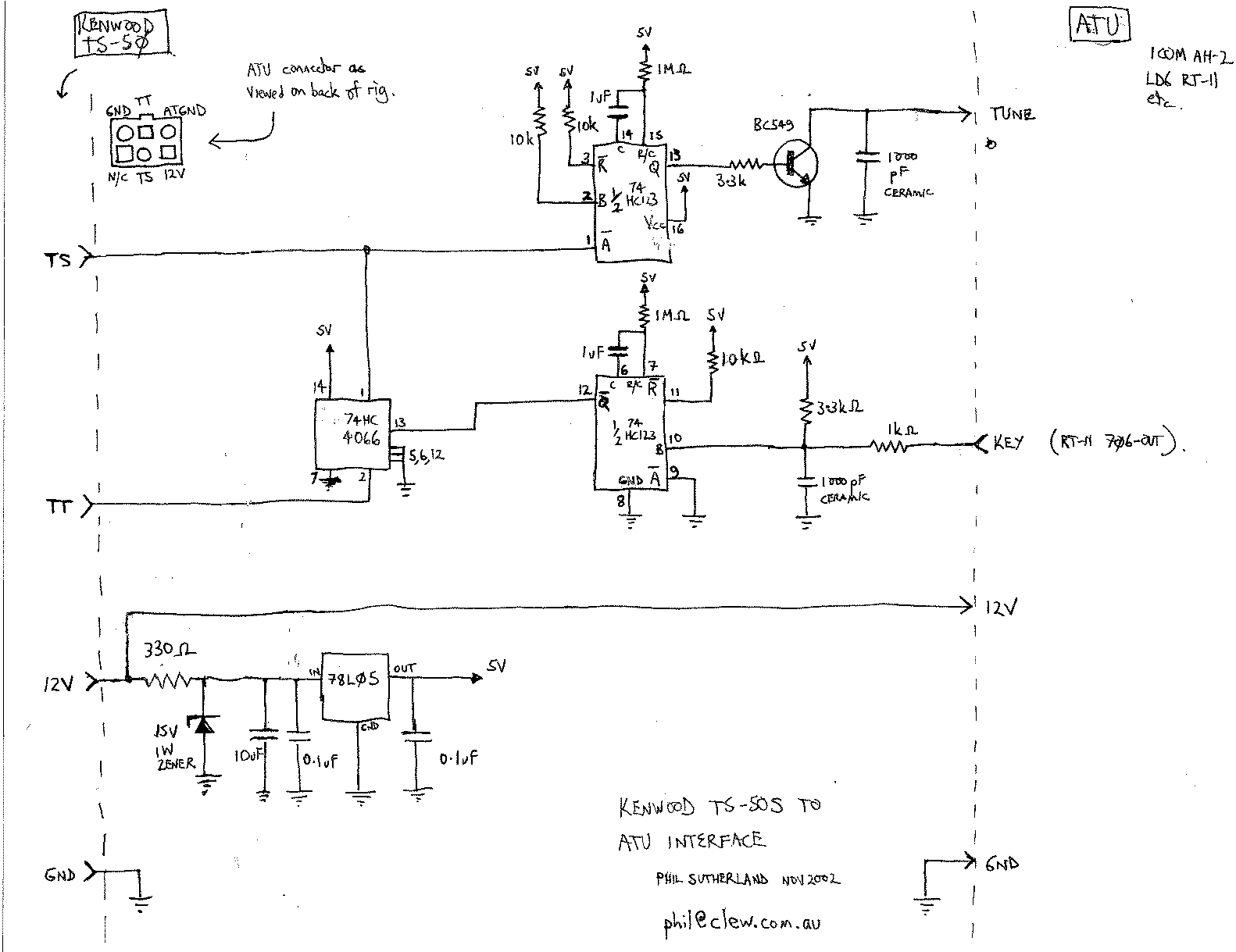
| | | | |
| TS-50S Australian Extended
Tx |
| Tx mod for TS-50S originally from
Sydney, Australia in 1995.
Review the mod where the coloured
picture of the control board is provided. This
shows a picture of D5. The pads for D1 through
D5 are obvious on the control board which is
piggy backed on the PLL board with 2 multipin
sockets and 2 screws.
This radio only had D4
obvious - snipping it did not do the job. D1, D2
and D3 were not fitted. (D5 not fitted next to
D4 - see below)
Disconnect the power.
Ground
the radio and keep one hand on the metal work or
use a wrist strap to ground yourself. Locate the
Control Board as it says in the Instruction
Manual for "Options Installation" and "TCXO UNIT
(SO-2)".
Remove the control board as it
says in the book.
The 3 plugs are not as such
plugs - the catch bar releases the ribbon cable
and is easy to push apart but a bit fiddly to
get back in. 3 hands might be needed and you
have to push the bar down as well as in. Very
little force is needed. Do not force it - if it
wont go in then you have not got the right
angle.
The 2 screws required the use of a
special tool which was not available. A fine
pointed set of side cutter wire snips can be
used to tightly grip the round headed screws by
the dimples.
Suggest you locate the 2 white
plug/sockets visually by looking under the
Control Board before you pull off the Control
board from the PLL board so that you dont bend
the pins since it has to go strait up at both
ends.
Under the board (under D5) was
found what looked like a blob of opaque glue
about 4mm diameter. Under this glue could be
seen a black speck. The glue was levered off and
a Surface Mount diode came off with it -
breaking away from the PCB track. Diode about
1.5*1mm. Obviously this blob was doing the
function of D5.
A full "Microprocessor
Reset" as it says in the Instruction Book gave
the desired result.
Other changes were also
successfull.
See instruction manual "MENU
SET-UP"
USB below 10MHz - alter Memory
location A04 from "SSB" to "ULC".
Double Zero
on frequency display - put "85" into memory B70
instead of "82".
Note also the mod in mods.dk which
explains what to do if the memory battery is
changed or disconnected. On replacement of the
memory battery you have to cycle the radio on
and then immediately off otherwise the memory
battery drain is 1mA and it will go flat very
quickly.
PS
WANTED: Does anyone know of a mod to make the
Kenwood TS-50S radio switch on with the Low
power option setting set. Altering Memory A00 to
10 does not do this. The radio switches on in
the power setting you last used it in, which is
not good for manual tuning if that happened to
be high
power. | | | | |
| Kenwood TS-50S Wideband TX & double zero
readout |
| New TS-50S to enable
Wideband TX cut D3 &D4 on the digital unit
X46 - 315X - XX.
On
TS-50S the mod is the same except cut D5
as well to enable.
Enable this mod entirely at your
own risk and responsibility.
Note; enabling the double
zero mod you will lose the RIT display, it's
activation is now indicated by a beep. To
reverse enable a partial reset by holding down
A/B and switch on, or, retain the 70/85 key 4
mic setting and normal function will resume at a
key press.
| | | | |
| TS-50
High-Power-Modification |
As the most of you TS-50-Users
surely know, it is possible to increase the
Medium-Power, the Low-Power but not the
High-Power-Setting. Reason: There is no
Trim-Pot, it is a small SMD-Resistor. With that
small Modification you'll get a Trim-Pot and the
TS-50 is able to run up to 180 W output without
any problems.
- Remove Top-Cover and hook out the
internal speaker. Place the rig top up, display
to you. The area you need is closed to the left
side of the CW-Filter-Board on the
main-RF-Board, where the Filter-Board is screwed
on.
On the board is printed on 'PL', 'PM',
'PH' and an arrow. Above are two pots and two
little black chips, the right one (SMD-Resistor)
is very closed to the second
pot.
- Remove this SMD-Resistor (R214,
10k), wich is located closed above the two pots
for Med and Low. It is a VERY small black chip,
marked with '103'. Be CAREFUL while
soldering!!
- Make yourselfer a small Board, 25
mm long, 8-10 mm wide. At one end drill a
centered 3mm-hole closed to the edge of the
board.
- Solder one conventional
4k7-Resitor (standing, a 5k6 or 6k8 also can do
it) and a conventional 10k-Trim-Pot (lying) in
serial order on this board.
Make sure, you
make no shorts and build the circuit as narrow
as possible and very closed to the reverse end,
from where you drilled the hole in - you later
need 10mm space at the drilled end!
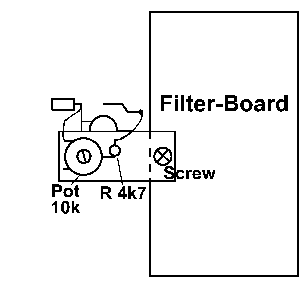
- Connect two two fine wires (length
aprox. 20 mm) at the ends of this little circuit
and solder it (CAREFULLY!!) to the free
solder-joints of the resistor. To make it a bit
easier: the right one you can solder to a joint
about 4mm away of it - just follow the small
trace to the right and you will find this
lonesome contact.
- Remove the screw of the
CW-Filter-Board, place your little board
hole-on-hole on top of the Filter-Board and
Re-Screw the two boards together to the
main-board. So your little "Tuning-Unit" is
fixed, hanging above the Med- and
Low-pot.
- Connect the rig to a power-supply
(25-30 Amps!), a power-meter, a dummy-load and
switch it on. No smoke? So you might have done
everything all right ;-)
- Push a FM-Carrier on 14Mhz and set
the 'new' pot on the desired output. My TS-50
can do max 185 Watts but I have adjustet it to
150-160, so it modulates fine 130 Watts SSB with
the original mike - what a difference to that 70
before... Don't adjust it to high, think about
your finals and filters!
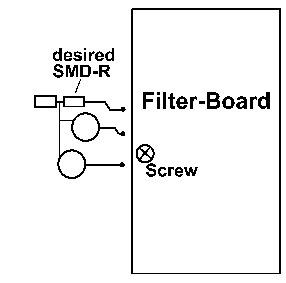
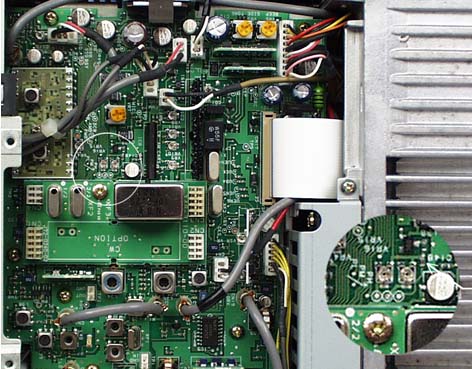
Thanks to Jim Duarte for this photo.
Note: You are making this
Mod on your own risk, I am NOT responsible!
| | | | |
| TX
0-30 MHz for the new TS-50 |
| ON the new version are 4 diode on
de board.
Cut remove all, D1 D3 D4 D5
Then RESET the Kenwood
TS-50 | | | | |
| TS-50 Modification Full time
"Double-Zero" |
This modification makes the
"double zero" display full time.)
- Turn on radio
Go to MENU
'B', item #70.
Program [85] into item 70.
This puts the 'double-zero' on the #4 (PF4)
button on the microphone. Press the F-LOCK to
get out of the menu function.
Press
'F-LOCK' [ON].
Press and hold PF4 button
on mic.
While holding PF4 button down on
the mic, press and hold the [SPLIT]
button.
Release the PF4 button -then-
release the SPLIT button.
Turn F-LOCK
[off].
Go back to MENU 'B', item '70',
and remove [85] or change the number.
| | | | |
| TS-50S "Hello" displayed during
TX |
Symptom:
Occasionally an
"Hello" message will appear in the display of
the transceiver when the TS-50S is loaded into a
antenna without the use of an antenna tuner.
This symptom usually occurs when the negative
terminal of the power supply is floating
(un-grounded for RF). This can result in RF
feedback that causes the supply voltage to
exceed to 16 Vdc.
Corrective action:
- Cut the Final Unit PC Board foil
in two places, as shown below.
Add a .01 µF
chip capacitor (C125) as shown below.
Add a
10 µH chip Ferri-inductor (L102) as shown
below.
Add an insulated jumper wire as shown
below.
Parts required: Qty Description Kenwood Part No. Circuit description
1 .1 µF chip capacitor CK73EB1E104K C125
1 10 µH Ferri-inductor L40-1001-48 L102
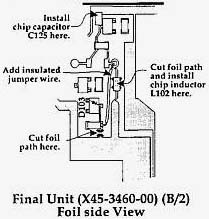
Caution: This
modification requires soldering equipment rated
for CMOS type circuits. It also requires
familiarity with surface mount soldering
techniques. If you do not have the proper
equipment or knowledge do not attempt this
modification yourself. Seek qualified
assistance.
| | | | |
| TS-50S Mechanical noise from final
unit |
| When the transceiver is subjected
to vibration a mechanical noise can be heard
from the output transformer area. This has led
to concern by several consumers that something
is loose or improperly installed.
Corrective Action:
In
order to ease consumer concern toy should add a
cushion under transformer L4 as shown in the
accompanying diagram, and replace transformer
L13 at the same time. This transformer has been
fastened to the circuit board with high
temperature adhesive, so use caution when
removing it from the circuit board.
Parts required: Qty Description Old part No. New Part No Circuit Description
1 Cushion NA G13-0871-04 (Under L4)
1 Output transformer L39-1209-25 L39-1252-05 L13
 | | | | |
| TS-50S Lithium battery replacement
notes |
|
Service Bulletin no. 1015 (10 May
1993)
Procedure:
Immediately
after replacing the Lithium battery you must
cycle the radio ON then OFF. Failure to follow
this procedure will result in premature failure
of the battery. If the power is not cycled ON
then OFF the microprocessor will immediately
begin drawing approximately 1 mA of power from
the Lithium battery, resulting in poor battery
life.
When the battery is replaced we
recommend the insulation sheet also be changed.
Part numbers for the battery and insulation
sheet follow.
Parts required: Qty Description Kenwood Part No. Circuit description
1 Lithium battery W09-0515-05 BA1
1 Insulating sheet F20-0521-04 --
Caution: This
modification requires soldering equipment rated
for CMOS type circuits. It also requires
familiarity with surface mount soldering
techniques. If you do not have the proper
equipment or knowledge do not attempt this
modification yourself. Seek qualified
assistance.
| | | | |
| TS50 FIX: LCD
display dark |
Problems:
No
display illumination, LEDs On Air, AT TUNE no function The menu item 2 has
no effect, display keeps always dark.
All other functions
normal.
Possible reason:
Bad contact LCD Assy for 5V line to R9,
R10 and IC5.
Power on the TS50 and check voltage at R9/R10.
If
voltage is 0V, but display readout is active, the reason might be as
discribed.
Measurement to fix it:
Look for the small hole near
R9 at the LCD Assy, component side view, where the contact between the two
sides of the LCD Assy is located.
If you have no service
manual:
This is the side oriented to the front side of the
device.
R9/R10 are located close to the two LEDs.
Take a small size
needle to pick through the contact hole to encrease the diameter.
Make
a contact between the two layers by soldering a piece of wire across the
hole.
Check the 5V at R9/R10.
| TS50<-->AT50
communication |
+-------------------------------------------------+
¦ TS-50 <--> AT-50 Communication ¦
+-------------------------------------------------¦
¦ as measured/discovered by DF6KR ¦
¦ No guarantee for whatsoever.... ¦
+-------------------------------------------------+
Communication method: Serial interface
Tranfer rate: 4800 bps
Synchronization: Start-stop (Asynchronous)
Parity: None
Signal format: TTL level (!)
+---+
+-------------------+
¦ +---+ ¦ 1: Ground
¦ 1 ¦ 2 ¦ 3 ¦ 2: TT (TS50<--AT50)TTL!
ACC ¦ +---+ +---+ +---+ ¦ 3: TS (TS50-->AT50)TTL!
¦ ¦ 4 ¦ 5 ¦ 6 ¦ ¦ 4: N.C.
¦ +---+ +---+ ¦ 5: ATG (signal ground)
+-------------------+ 6: +13.8V from TS50
Rear Panel Connector ACC
Timing:
1. at Power-on:
===============
+------------------+ ++1 ++3++6
TT--+ +---------------------->
| | | | |
| 1.45 sec---+ | | |
+--+ ++2 +-+4,5
TS--+ +--------------------------------------->
| |<- 600ms->|
0 + 90ms resume time t
Signal:
1 3 6
TT: ;;;;;0C;___0D01;__________0F11;
2 4 5
TS: ________0C;_____0D01;0F11;____
1: Power on comm.
2: Power on answer
3: Auto on request
4: Auto resume finished
5: ok at50
6: ok answer ts50
2. DOWN-UP-Communication
========================
TT: 0E02;__________0F11;__ - UP from 1.8 to 3.5
TS: _____0E02;0F11;_______
same:
0E04;0E04;0F11;0F11; UP 3.5 --> 7
0E05;0E05;0F11;0F11; UP 7 --> 10
0E06;0E06;0F11;0F11; UP 10 --> 14
0E07;0E07;0F11;0F11; UP 14 --> 18
0E08;0E08;0F11;0F11; UP 18 --> 21
0E09;0E09;0F11;0F11; UP 21 --> 24.5
0E0B;0E0B;0F11;0F11; UP 24.5--> 28
0E0C;0E0C;0F11;0F11; UP 28 --> 29
0E01;0E01;0F11;0F11; UP 29 --> 1.8
DOWNs
0E0C;0E0C;0F11;0F11;
0E0B;0E0B;0F11;0F11;
.
.
0E01;0E01;0F11;0F11;
TUNE: 0D03;0D03;0F41;0F41;
AUTO OFF (THRU): 0D00;0D00;
AUTO ON: 0D01;0D01;
tune error: 0d03;0d03;0F83;0F83;
|
| just got a spanking new Kenwood
TS-50S.
Searching around the local LLBBS's
I found a very simple mod for full transmit from
1.7 - 30 mhz....
Remove the bottom cover of the
TS-50
Locate the PLL board -- it is the
pc board on top of the main board, it has a
shield on it's right side.
Locate the only non-surface
mounted component on the PLL board -- look near
the rear left-hand side of the pll board (front
of radio facing you) and remove the very obvious
diode. You can't miss, ther's only one.
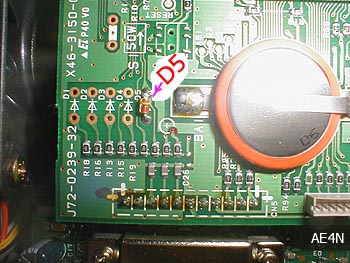
Replace cover.
| | | | |
| 
|

|

|

|
 KB2LJJ
KB2LJJ








